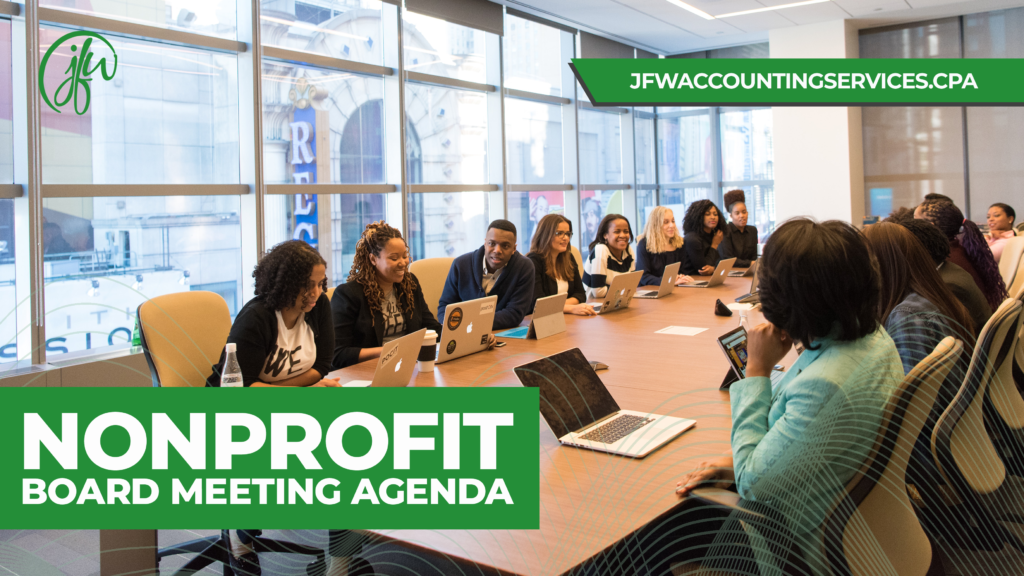Running effective board meetings is a duty of every nonprofit organization. The outline or driving document in a board meeting is the agenda. Having a strategic board meeting agenda prepared ahead of time will ensure the board meeting accomplishes the goals and needs of the organization. In this blog, we will discuss the elements of a sample nonprofit board meeting agenda.
Purpose Of A Board Meeting Agenda
The purpose of an agenda is to make sure required board meetings have organizational flow. Preparing a detailed agenda sets the structure for the meeting so that important topics are included, and attendees understand their responsibilities. By distributing the agenda prior to the meeting, presenters are given time to prepare, and related individuals have an opportunity to add a topic to the agenda.
The agenda provides an outline for the meeting to be sure that the goals are accomplished in the allotted time slot. It also provides a guide for the secretary or other member, that is responsible for recording the meeting minutes.
To run a great nonprofit board meeting, follow these tips:
- Prepare a strategic, mission-focused Board Meeting Agenda
- Distribute the agenda prior to the meeting
- Conduct the meeting within the scheduled time
- Make decisions and obtain approvals during the meeting
- Take accurate meeting minute notes during the meeting
Since the meeting runs around the prepared agenda, we have provided the following guidance on preparing an effective board meeting agenda.
9 Components Of A Board Meeting Agenda
Introduction
This section is added to the agenda to leave time for introductions and to take attendance. It allows the board chair, or the person facilitating the meeting, to introduce new board members and any other individuals in attendance. Once introductions are done, this section allows the chair to discuss how the meeting will run and be sure that everyone in attendance understands the agenda.
Previous Meeting Minutes
This section of the meeting is for reviewing the board minutes from the previous meeting. The minutes are recorded at each meeting by the board secretary or other member and give a detailed account of what was discussed as well as when and by whom it was motioned and approved. Since they are put together after each meeting, they are approved at the following meeting.
Reporting
This section permits discussions regarding any non-financial reports. Examples of reports discussed here would be the program committee reports. Often the executive director shares a report or information at this time as well.
Treasurer’s Report
This section of the agenda allows for a financial discussion to discuss cash flow, revenues, expenses, and debt. Any changes in income or finances since the last meeting are highlighted and the treasurer or management will share details about any extraordinary upcoming expenses.
Old Business
At this time in the meeting, unfinished business is discussed. Any topics or discussions that were tabled at previous meetings are revisited.
New Business
The new business gives the board members an opportunity to talk about new projects or issues. This portion of the meeting allows conversations about nonprofit awareness, outreach, fundraising opportunities, donors and members, and anything else pertaining to the mission or the organization.
Other Relevant Topics
This section is optional and allows for correspondence pertaining to member requests or organizational calls to action. This part of the meeting gives time to address upcoming events, volunteer opportunities, and other organizational needs.
Other Business
At this time in the meeting guest presentations and discussions by the public or board members are permitted. There may be a scheduled speaker requested by the board, or interested parties wishing to share. It’s recommended that the board chair facilitate this “open discussion” time so that it does not become too lengthy.
Next Meeting
Before adjourning, the date of the next meeting is decided and announced.
The agenda should be prepared before the meeting and distributed to attending members. Even if the agendas are sent out prior to the meeting, it is a good idea to have copies available at the meeting as well. To prepare the agenda, use the guide above or download a free template.
Bottom Line
Nonprofit organizations need Boards because they provide strategy and oversight. They are an organization’s greatest defense against risks, including non-compliance. The Board may have responsibilities to direct programs, lead fundraisers, and manage the employees. To stay on track with all of its duties, every Board is required to participate in Board meetings. Having the right agenda makes sure that all topics are covered, and everyone is on the same page.

Jo-Anne Williams Barnes, is a Certified Public Accountant (CPA) and Chartered Global Management Accountant (CGMA) holding a Master’s of Science in Accounting (MSA) and a Master’s in Business Administration (MBA). Additionally, she holds a Bachelor of Science (BS) in Accounting from the University of Baltimore and is a seasoned accounting professional with several years of experience in the field of managing financial records for non-profits, small, medium, and large businesses. Jo-Anne is a certified Sage Intacct Accounting and Implementation Specialist, a certified QuickBooks ProAdvisor, an AICPA Not-for-Profit Certificate II holder, and Standard for Excellence Licensed Consultant. Additionally, Jo-Anne is a member of American Institute of Certified Public Accountant (AICPA), Maryland Association of Certified Public Accountants (MACPA), and Greater Washington Society of Certified Public Accountants (GWSCPA) where she continues to keep abreast on the latest industry trends and changes.

